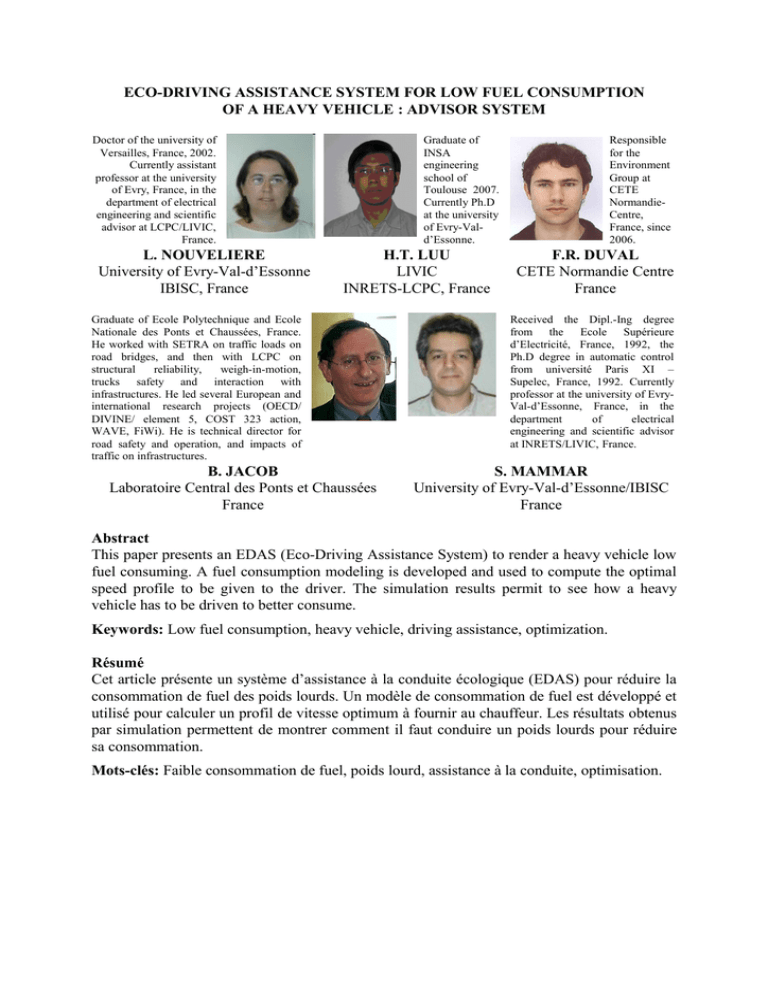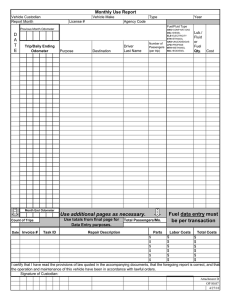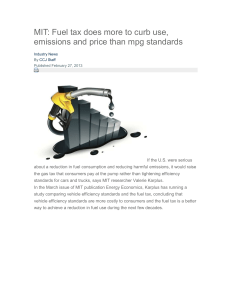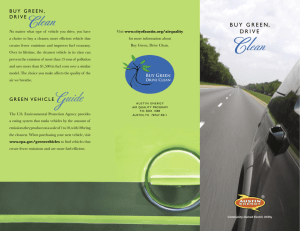ECO-DRIVING ASSISTANCE SYSTEM FOR LOW FUEL CONSUMPTION
advertisement

ECO-DRIVING ASSISTANCE SYSTEM FOR LOW FUEL CONSUMPTION OF A HEAVY VEHICLE : ADVISOR SYSTEM Doctor of the university of Versailles, France, 2002. Currently assistant professor at the university of Evry, France, in the department of electrical engineering and scientific advisor at LCPC/LIVIC, France. L. NOUVELIERE University of Evry-Val-d’Essonne IBISC, France Graduate of INSA engineering school of Toulouse 2007. Currently Ph.D at the university of Evry-Vald’Essonne. H.T. LUU LIVIC INRETS-LCPC, France Graduate of Ecole Polytechnique and Ecole Nationale des Ponts et Chaussées, France. He worked with SETRA on traffic loads on road bridges, and then with LCPC on structural reliability, weigh-in-motion, trucks safety and interaction with infrastructures. He led several European and international research projects (OECD/ DIVINE/ element 5, COST 323 action, WAVE, FiWi). He is technical director for road safety and operation, and impacts of traffic on infrastructures. B. JACOB Laboratoire Central des Ponts et Chaussées France Responsible for the Environment Group at CETE NormandieCentre, France, since 2006. F.R. DUVAL CETE Normandie Centre France Received the Dipl.-Ing degree from the Ecole Supérieure d’Electricité, France, 1992, the Ph.D degree in automatic control from université Paris XI – Supelec, France, 1992. Currently professor at the university of EvryVal-d’Essonne, France, in the department of electrical engineering and scientific advisor at INRETS/LIVIC, France. S. MAMMAR University of Evry-Val-d’Essonne/IBISC France Abstract This paper presents an EDAS (Eco-Driving Assistance System) to render a heavy vehicle low fuel consuming. A fuel consumption modeling is developed and used to compute the optimal speed profile to be given to the driver. The simulation results permit to see how a heavy vehicle has to be driven to better consume. Keywords: Low fuel consumption, heavy vehicle, driving assistance, optimization. Résumé Cet article présente un système d’assistance à la conduite écologique (EDAS) pour réduire la consommation de fuel des poids lourds. Un modèle de consommation de fuel est développé et utilisé pour calculer un profil de vitesse optimum à fournir au chauffeur. Les résultats obtenus par simulation permettent de montrer comment il faut conduire un poids lourds pour réduire sa consommation. Mots-clés: Faible consommation de fuel, poids lourd, assistance à la conduite, optimisation. 1. Introduction In 2005 in France, 553 million tons of greenhouse gas (GHG) were emitted, thus decreasing the French crude emissions of 2% between 1990 and 2005. But in the same time, the emissions due to the transportation have increased by 22%, and the transport represents one third of the total energy consumption. The governmental objective is to reduce by 20% the energy consumption the greenhouse emissions in the transports by 2020. The fuel consumption is responsible for 35% of the nation-wide emissions of CO2. The main GHG effect of rejections increases because of the strong raise of displacements, while the trucks represent 26% of these emissions (ADEME source, France). Because of the high oil prices and the stakes of the greenhouse effect reduction, more and more vehicle drivers look for a low fuel consumption behavior. The economy-ecological way of driving (eco-driving) is a citizen driving behavior, which allow to reduce the fuel consumption up to 15%, limiting the GHG effect responsible for the climatic warming, and to decrease the risk of accidents (by 10 to 15%). 2. About Fuel Consumption Modeling The principles of modeling the fuel consumption and polluting emissions are based on the calculation of the fuel consumption and polluting emissions of a given traffic on a given road network. These computation models consist in associating an emission factor database with a running motor fleet of vehicles. The model is fed with a traffic data set characterizing a specific situation (traveled distances, current speeds, HDV/LDV/motorcycles distribution, slope, cold start, load rate). In-motion and static fleets of vehicles should not be mixed up. The static fleet comprises all the vehicles owned by households, companies and institutions of a country. The in-motion fleet of vehicles comprises, for a given year, the distribution of kilometers covered by the vehicles of the static fleet according to the type of vehicles. The current French in-motion fleet was assessed by the INRETS (French National Institute for Transports and Safety Research) from the 1990s until 2025. The emission factor is expressed in g/km, while the consumption or polluting emissions depend on the vehicle type (class, carburation, age) for a given speed or driving cycle. The scientific and technical network of the French Ministry for Ecology, Energy, Sustainable Development and Planning, and the Sea, has developed a consumption and pollutant emissions modeling tool, related to the road transports. The software, called COPCETE, was originally created to fulfill the environmental requirements related to the road projects. COPCETE is a tool based on the European COPERT methodology (Computer Program to calculate the Emissions from the Road Transport) used to compute the fuel consumption and emissions of different road vehicles (European Environment Agency, 2007). It combines an emission factor database of different vehicles according to the COPERT methodology and the French in-motion fleet assessed by the INRETS. Since 2007, a new methodology emerged, named ARTEMIS (Assessment and Reliability of Transport Emission Models and Inventory Systems), developed by a consortium of European research organizations (INRETS, 2006), (EU, 2007). This new methodology takes more accurately in account the traffic conditions compared to the old COPERT methodology, which only considered the average speed. ARTEMIS does not compute the instantaneous emissions based on the traffic conditions, but provides the data pre-calculated from some predefined driving cycles. Modeling the fuel consumption and polluting emissions requires to know emission vehicles factors, but also a precise knowledge of the in-motion fleet of vehicles. This is the current limitation. The in-motion fleet of heavy commercial vehicles is not known as accurately as the light duty vehicle fleet. Therefore, the tonnage transported on the French road network is not accurately known. Currently, this raw estimation leads not to exploit all the potential of the emission models, which however already contain rather accurate levels of vehicles classification with respect to their tonnage and loading rate. Low fuel consumption strategies and low emission systems, would require models, currently designed to follow the vehicles fleet behavior, able to characterize the fine kinematics variations of a single vehicle. A first advisor system is presented in this paper, with some simulation results, for a heavy vehicle low consumption. 3. Longitudinal Heavy Vehicle Modeling 3.1 Hypothesis Table 1 – Heavy vehicle parameters x v ωr ωm Rg Rt Rtd Tmap Tm Tacc Tf Ca Cr m g Jm Jr θ α τm τg Longitudinal displacement Longitudinal speed Wheel speed Engine speed Total gear (gearbox+differential) Gear Desired gear Desired engine torque Engine torque Auxiliary torques (air conditioning,...) Braking torque Aerodynamic coefficient Rolling resistance coefficient Heavy vehicle mass Gravity Engine inertia Wheel inertia Road slope Throttle angle Time constant for engine Time constant for gearbox By only taking into account the longitudinal mode, several hypothesis can be done: - the heavy vehicle structure is stiff, - a non-slip assumption is done : v = rωr, - the torque converter is locked : ωr = Rgωm, - the power of the heavy vehicle accessories (air conditioning, ...) is supposed to be constant : Taccωm = Pacc = constant. 3.2 State Equations With these hypothesis and the Fundamental Principle of Dynamics applied to the tire/road contact, the state equations can be obtained. The gearbox inertia and the effectiveness of its slowing down system are considered. Table 2 – Powertrain parameters ωconv Tconv Tdiff Tralent Kralent Rdiff Jbv µ(), λ() JConvIn JConvOut ωr Output speed of the torque converter Output torque of the torque converter Differential torque (wheel shaft) Slowing down torque of gearbox Slowing down coefficient Reduction ratio of the differential Gearbox inertia Intermediate functions Primary inertia of torque converter Secondary inertia of torque converter Wheel speed The state equations are given, with a state vector: [ X = x ωr Tf ω m Tm ] x˙ = v = rω r J eq ω˙ r = Tdiff − Tres 1 (T f map ( β ) − T f ) 3τ f 1 T˙m = (− Tm + Tmap (α , ω m )) 3τ m with _ bypass : ω m = ω conv T˙ f = without _ bypass : ω˙ m = (1) Tm − Tacc − λ (Gconv )ω J m + J ConvIn 2 m with the total inertia with _ bypass : J bv R g + J m + J ConvIn + J ConvOut J eq = without _ bypass : R 2 g J bv R g + J ConvOut R 2 g + mr 2 + N r J r + mr 2 + N r J r and the strong torque Tres and the differential torque Tdiff ( Tres = r C a v 2 + C r mg cos(θ ) + mg sin(θ ) Tdiff = ) Tconv T (ω ) + K ralent ralent m Rg Rdiff with the following parameters (speed and torque at the converter output) ω ω conv = r Rg Tconv = with _ bypass : Tm − Tacc without _ bypass : ω m2 µ (Gconv )λ (Gconv ) with ω conv ωm All the equations depend on the status of the torque converter (with converter bypass or not). The braking system and the engine are represented by a first order dynamic. The engine has time constant τ m using an engine cartography linking the engine speed ω m and the throttle angle α . Gconv = The simulation of this heavy vehicle modeling, comparing the model with and without the torque converter, is shown in Figure 1. The parameter values and the engine map are given in (Nouveliere, 2008b). Figure 1 – Heavy vehicle modeling : torque converter influence 4. Fuel Consumption Modeling The truck fuel consumption versus influencing parameters such as the engine speed and torque, or the road grade for a given trip, is given in this section. The model is validated with experimental data of heavy vehicle fuel consumption. The instantaneous fuel consumption f c is evaluated versus the engine speed ω m and the engine torque Tm : f c = β 1 + β 2ω m + β 3ω mTm + b4Tm if Tm < 0 (2) = α + γ ωm + θ ωm2 if Tm ≥ 0 where the parameters β 1 , β 2 , β 3 and β 4 or α , γ and θ are estimated from experimental data with a least square method. The detailed development of this model is presented in (Luu, 2009). The fuel consumption along the trip FC is obtained by: FC = K−1 ∑ k= 0 f c k (ω m , Tm ) (3) The simulation of this fuel consumption modeling is represented in Figure 2 by the estimation error between experimental consumption data and the consumption model for a heavy vehicle. This error is rather low. Figure 2 – Fuel consumption modeling : estimation error compared to experimental data The estimation error does not exceed 6% (at the map extremity) and 2% elsewhere. 4.1 Criterion Formulation In order to optimize the heavy vehicle fuel consumption, a criterion J is defined, which shall be minimized by optimization under constraints. The objective function is the sum of three factors which represent different objectives. The importance of each factor is defined by weighted coefficients Qi as follows: J = Q1.FC + Q2 .T + Q3 .SMOOTH (4) The variable T represents the trip time. SMOOTH is used to face to the penalty induced by a speed change by obtaining a smoother driving. SMOOTH is expressed by: SMOOTH = K−1 ∑ k= 0 ( A(max(0, vk + 1 − vk )) + (1 − A)abs (min(0, vk + 1 − vk ))) (5) where vk is the instantaneous heavy vehicle speed at the instant k, and A is a weight coefficient to be tuned to take into account the comfort. The passenger comfort will be considered for a car or a bus, while the “loads comfort” will be considered for a truck. 4.2 Problem Formulation The fuel optimal control problem can be written under its classical discrete form: K min ∑ J k ( X k ,U k ) U k= 0 X k + 1 = f ( X k ,U k ,θ k ) X k ∈ [ X lbk , X ubk ] (6) X (0) = X 0 X (N ) = X N xk where X k = is the state vector including the heavy vehicle position and speed and vk T U k = mk is the control variable consisting in the engine torque and the gear ratio. Gk Gk is determined by a function g(s) that links the speed and the road gradient to the gear ratio. The intervals [ X lbk , X ubk ] and [U lbk , U ubk ] represent the different constraints imposed on the state and control variables in each computation step. The longitudinal motion of the vehicle f ( X k ,U k ,θ k ) is a function of various heavy vehicle parameters (gear ratio, performance of transmission, ...), of the road (slope) and the weather (aerodynamic resistance,...). The initial states are known and the final states may be known or unknown. 4.3 Dynamic Programming Technique The recurrent Hamilton-Bellman-Jacobi equation must be solved to achieve the optimization problem (6) (Bellman, 1957), (Hooker, 1983). JN = ς N (X N ) for k = N − 1.....0 (7) J k ( X N ) = min (ς k ( X k ,U k ) + J k ( f ( X k ,U k ))) Uk where ς k is the cost to move from one state to another. The numerical solution of this equation is obtained by the inverse dynamic programming technique, which consists of two inverse steps. The first step computes the optimal control versus the states. The second step rebuilds the optimal control from the initial states, using the stored mapping at each inverse iteration. The results of the dynamic programming algorithm are presented in the next section. 5. Simulation Results The optimization method developed in the previous sections does not work with a complex heavy vehicle model, above all with the torque converter that creates a mathematical structure changing and real time constraint. The heavy vehicle modeling without torque converter is then used for the optimization (model for synthesis procedure only), but the resulted optimal speed profile can be replayed with the complex heavy vehicle model. All the simulations are obtained for a 1000 m traveled distance, with a 10 m sampling interval, using the city bus parameters: m=22 tons, Ca=0.6. The consumption modeling has been estimated with experimental data from a city bus with the previous characteristics. The engine map is known (Nouveliere, 2008b). Then the coefficients to be estimated in the equation (4) are easy to obtain using the least square method. The different constraints [ X lbk , X ubk ] and [U lbk , U ubk ] on the heavy vehicle states and variables are the following : Heavy vehicle speed : vlb = 0 m/s, vub = 30 m/s Heavy vehicle acceleration : alb = -3 m/s2, aub = 3 m/ s2 Figure 3 - Optimal speed profile with Q1=1, Q2= 4, Q3=1, A=0.4 (42.098 l/100 km) Figure 4 - Optimal speed profile with Q1=1, Q2= 4, Q3=1, A=0.4 (19.2298 l/100 km) Figure 5 - Optimal speed profile with Q1=4, Q2= 4, Q3=1, A=0.4 (30.4605 l/100 km) Figure 6 - Optimal speed profile with Q1=3, Q2= 1, Q3=3, A=0.4 (30.0754 l/100 km, 70 s) Figure 7 - Optimal speed profile with Q1=1, Q2= 4, Q3=1, A=0.4 (30.0901 l/100 km, 58 s) Heavy vehicle engine torque : it is constrained by the maximum and minimum allowed engine torques of the heavy vehicle given by the engine map. The comparison of Figures 3 and 4 leads to the influence of the road slope. The anticipation of a heavy vehicle to approach a slope is fundamental for the consumption. In Figure 3, a zero slope section before a slope of 500 m, leads to a 42 l/100 km consumption, while in Figure 4, an initial slope of -3% allows the heavy vehicle to anticipate the next slope and to approach it with enough power. The fuel consumption obviously is reduced to 19.22 l/100 km. Figures 3 to 5 show the influence of the Q1 weight coefficient on the fuel consumption reduction along a distance of 1000 m : 42 l/100 km with Q1=1 and 30.5 l/100 km with Q1=4 (with no change for the others parameters). The Q2 value denotes the importance of the travel time over 1000 m. Q2=1 leads to a 70 s travel time (Figure 6) and Q2=4 allows a 58 s travel time (Figure 7), for a constant fuel consumption of app. 30 l/100 km. 6. Driving Assistance System: Advisor System This fuel consumption optimization is to be used in an advisor system, to help the heavy vehicle drivers to reduce their fuel consumption. The computed optimal speed profile is displayed to the driver via an human-machine interface (HMI), still to be designed, which shall not affect driver’s attention. Such a driving assistance aims to softly implement an ecodriving behavior, respecting the desired inputs from the HMI. This assistance may be active if an eco-speed controller is added. 7. Gain Analysis The fuel consumption gain obtained with this kind of assistance is not very easy to evaluate without experimental test involving several drivers. However, these algorithms have already been tested on a light vehicle model; many simulation tests showed that the gain could be higher for heavy vehicles: the main difference is because heavy vehicles must anticipate their maneuvers, e.g. approaching a long slope. The presented algorithms may help the driver to anticipate such situation, if he is advised by an HMI on an optimal speed. 8. Conclusion An algorithm for low fuel consumption applied to a heavy vehicle is presented and used for the design of an advisor driving assistance system. The dynamic programming method is used, coupled to a fuel consumption modeling based on experimental data. The results are evaluated by simulation, tuning some weight coefficients which influence the consumption, the travel time and the comfort. A good compromise between these three criteria must be found. Such an EDAS system can simultaneously bring an ecological improvement and an economical gain. 9. References • • Bellman, R. (1957), Dynamic Programming. Princeton University Press, Princeton, NJ. Luu, H.T. (2009), Modélisation de la consommation en carburant d’un véhicule léger à partir de données expérimentales, JD-JN-MACS, Angers, France. • • • • • • • Nouveliere, L., Menhour, L., Braci, M., Mammar, S. (2008), Infrastructure based fuel consumption optimization of a vehicle, AVEC08, Kobé, Japan. Nouveliere, L., Braci, M., Menhour, L., Luu, H.T. (2008b), Fuel consumption optimization for a city bus, UKACC CONTROL08 Conference, Manchester, England. Hellstrom, E. , Froberg, A., Nielsen, L. (2005), A real-time fuel-optimal cruise controller for heavy trucks using road topography information, number 2006-01-0008 In: SAE World Congress. Detroit. European Environment Agency (2007), COPERT 4 - Methodology for the calculation of exhaust emissions, August 2007. INRETS (2006), Traffic characteristics for the estimation of pollutant emissions from road transport, ARTEMIS WP1000 research project, March 2006. EU Commission (2007), Artemis road emissions model, user guide, october 2007. Hooker, J. (1983), Optimal control of automobiles for fuel economy, Transportation Science., vol. 17, No. 2.





